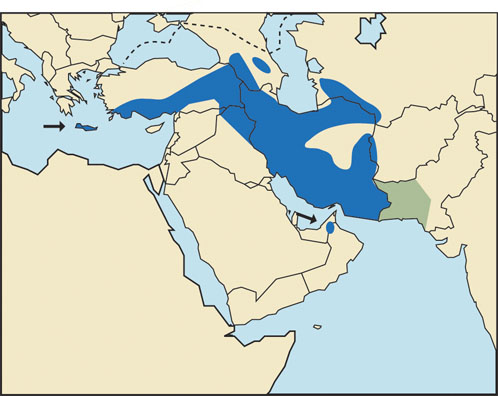 |
 |
Capra aegagrus aegagrus
Bezoar (Sp), Bezoarziege, Pasang (G), Chèvre à bézoard, Pasang, Egagre (F). Called pasang, which is Farsi for "rock-footed" in Iran. Also called Persian ibex, Turkish ibex, or bezoar goat. A bezoar is a hard mass of ingested material (such as hair) that forms in the stomach or intestine of a ruminant and was once believed to possess magical properties, such as serving as an antidote for poisons. Bezoar is Spanish, from the Arabic bazahr, or the Farsi (Persian) padzahr, meaning to protect from poison. Aegagrus is from the Greek aigagros for wild goat.
DESCRIPTION (male) Shoulder height 30-37 inches (76-94 cm). Weight 100-200 pounds (45-90 kg). Females are smaller.
The bezoar is a handsome animal, its blackish-brown markings contrasting with the lighter body color. Summer coat is reddish-brown, turning brownish-gray in winter, with old males ashy-gray. Underparts and back of legs are white. The dark blackish-brown areas include the face, throat, chest, dorsal stripe, shoulder stripes, flank stripes, front of legs, and tail. The chin beard is long and black and, in old males, as wide as the chin. Callouses develop on the knees and sometimes on the chest. Males have large, laterally compressed, scimitar-shaped horns. The front edge is sharp, forming a keel for some distance, above which are bold, sharp-edged, widely separated knobs. Females grow short, slender horns and do not have beard. They are tawny-brown at all seasons, with a dark stripe from eye to muzzle.
BEHAVIOR A gregarious herd animal, although older males are usually solitary or in small bachelor groups. Mates in late autumn, with the kids (usually two) born five months later.
Sedentary, living its life in a small area. Favors steep, rocky terrain, whether in forests or arid regions. May be diurnal or nocturnal, depending on predator and human activity, but older males tend to sleep in hiding places (often caves) by day and feed at night. Both grazes and browses, often climbing trees to feed. Has been seen in trees 20 feet (6 m) above the ground, and on limbs extending out over sheer cliffs. Drinks water regularly when available, usually very early or late, or even after dark. Some observers believe it can exist indefinitely without drinking free water. Extremely surefooted and agile. All senses are acute.
HABITAT Rugged mountain country, rocky areas, and adjacent meadows.
DISTRIBUTION Anatolia (Asian Turkey), northeastern Iraq, most of Iran and adjoining western Afghanistan. Also in the eastern Caucasus (where it is said to be rare) and extreme southern Turkmenistan. Its range overlaps that of the east Caucasian tur in the Caucasus, although the tur is at higher elevations. Boundaries with the Sindh ibex to the east are unclear.
Outside of Asia, it is found in Europe on the island of Crete and on a number of Aegean islands; however, on many islands it has interbred with domestic goats. There is an introduced population in the Moravian region of the Czech Republic near the Austrian border. Also introduced in the wild in New Mexico, U.S.A. Found on game ranches in many places.
REMARKS An excellent game animal whose horns make a spectacular trophy.
|





